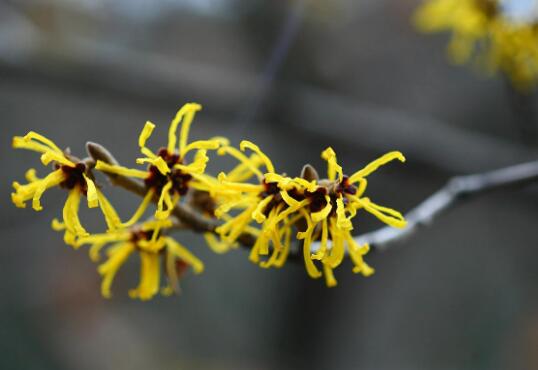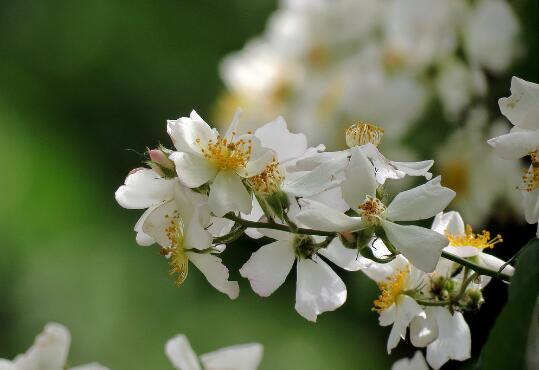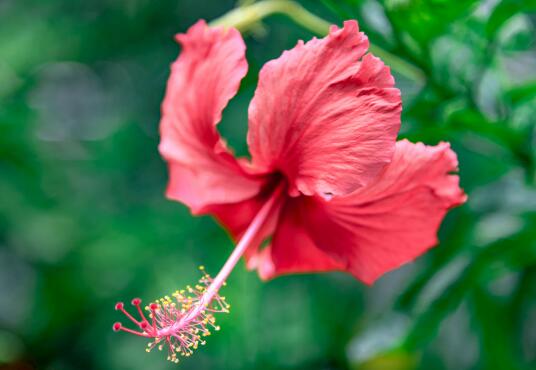What to do with the worms of witch hazel? pest control of witch hazel / 2 insect pests and 3 diseases
Plant diseases and insect pests are the most unwanted situation in the process of plant growth, and witch hazel is no exception. This kind of problem is very harmful to it, which not only affects its ornamental, but also leads to its death. So what if the witch hazel grows worms? What should be done to control the diseases and insect pests of witch hazel? Next, the editor will take you to learn about it.
First, witch hazel worms how to do, find the reason

If we want to know what to do with witch hazel worms, we first need to know what worms grow, so that we can deal with them specifically, because the prevention and control methods of each kind of diseases and insect pests are different, and we need to prescribe the right medicine to the case. Below, we can learn about the symptoms and treatment of various high-incidence diseases and insect pests of witch hazel.
II. Pest control of witch hazel (pest)
Spodoptera litura
The big coir moth is a kind of moth of the genus Lepidoptera. The high incidence period of this pest is from February to March every year, and it is one of the main pests in the early spring of the tea garden, so we should pay special attention at this time. This pest mainly bites on the leaves and shoots of witch hazel or strips off branches and fruit skins, resulting in local baldness of tea bushes.
Control method: for this kind of witch hazel pest, we can remove the insect sac in time and destroy it, or we can use 1200 times of dichlorvos EC to directly spray the pest.
Leaf roll moth
Spodoptera litura is a small pest. Its adult length is about 10mm and its wings spread 23-30mm. As long as the pest lurks on the leaf tip of witch hazel during the larval period, and then gradually feeds on the epidermis and mesophyll, resulting in many holes in the leaves, which seems to affect the ornamental.
Control method: when we deal with the diseases and insect pests of witch hazel, we spray it with 1000 times of phoxim or 1000 times of trichlorfon.
III. Pest control of witch hazel (disease)
Anthrax
Anthracnose mainly occurs in the leaves of witch hazel. At the initial stage of the disease, there are many water-stained yellow spots on the leaves, and after expansion, there are oval to irregular brown or yellowish-brown spots. In the later stage, the disease spots will cause the leaves to dry up and produce small black spots with wheel patterns.
Prevention and control methods: the emergence of this disease is mainly due to poor ventilation in the maintenance environment, so we must maintain environmental ventilation when breeding. As for the treatment of this disease, we can use 65% Dyson zinc wettable powder 600 times to spray the disease, usually once a week, 3-4 times can be cured.
Leaf spot disease
Leaf spot is a widespread disease, which is harmful to many plants, and witch hazel is one of them. if it is affected by this disease, many irregular brown spots will appear on the leaves, and will spread gradually with the passage of time, resulting in the gradual death of the plant.
Prevention and control methods: when we deal with the diseases and insect pests of witch hazel, we must begin to restrain them at the initial stage. We can spray the diseased plants with 1000 times of silazole and prochloraz, usually once every 7-10 days, about 3 times.
Powdery mildew
Powdery mildew is a disease caused by fungi. Many white powdery mildew spots appear on the leaves of witch hazel, and gradually cover the whole leaf with the passage of time, affecting its photosynthesis and interfering with its normal metabolism. resulting in premature senility.
Prevention and control methods: for this kind of witch hazel diseases and insect pests, we can choose to use 2% antimycin water agent 200x liquid or 15% strychnine 1000 times liquid to cure it, usually once every 3-6 days, 3-6 times in a row.
What to do when buttercups grow worms? pest control of buttercups / 2 insect pests and 3 diseases
In the growth process of buttercup, the last thing we want to encounter is diseases and insect pests, this kind of problem is very harmful to the plant, not only affect the ornamental, but also lead to plant death. So what should we do if buttercups have worms? How to control the diseases and insect pests of Goldilocks? Next, the editor will take you to learn about it.
First, buttercup worms how to do, to find the reason
If you want to know what to do with buttercup worms, we must first understand what kind of insects grow, so that we can carry out targeted treatment, because the treatment methods of each kind of diseases and insect pests are different, and the details are introduced below. Friends who are troubled in this respect can take a look.
II. Pest control of buttercup (pest)
1. Shell worm
Scale insects prefer to grow in a warm and humid environment, which is easy to occur if the growth environment is too dry. It mainly threatens the branches, leaves and fruits of buttercup, which will cause the leaves to turn yellow gradually, the tree potential will gradually decline, and finally wither.
Control method: when we deal with the diseases and insect pests of this buttercup, we can spray it directly with 1000 times of imidophos or 2.5 times of deltamethrin.
two。 Aphids
Aphid is a plant-eating insect, which mainly absorbs the juice from the leaves of Jinfeng, which leads to the gradual green fading of the leaves, and in serious cases, it will lead to the continuous shrinkage and shedding of the leaves and affect its flowering.
Control method: for this kind of buttercup diseases and insect pests, we can directly use 50% marathon emulsion 1000 times or 50% aldicarb wettable powder 3000 times to spray it.
III. Pest control of Goldilocks (diseases)
1. Powdery mildew
Powdery mildew is a disease that may occur in many plants, and buttercup is no exception. During the disease, many white dust-like disease spots will appear on its leaves, and will gradually cover the whole leaf over time. As a result, the plant is unable to carry out photosynthesis and gradually die.
Control methods: when we deal with the diseases and insect pests of buttercup, we can use 1000 times of methyl topiramate wettable powder to spray the diseased plants, generally spraying once every half a month, about twice can be cured.
two。 Blight disease
This disease mainly affects the rhizome of buttercup, resulting in blackening or constriction of the rhizome, and white mildew in a humid environment. In general, the leaves of plants will wither within a few days when they are affected by this disease, and the whole plant will gradually die over time.
Control methods: in view of the diseases and insect pests of Goldilocks, we can use 1200 times of methyl iridofos EC to control the diseased plants, usually once every 7-10 days, 2-3 times can be cured.
3. Brown spot disease
Brown spot, also known as leaf spot, is a disease caused by fungi, which mainly threatens the leaves of plants. Many brown spots will appear on the leaves during the disease, and will spread gradually with the passage of time, resulting in plant death.
Prevention and control methods: when dealing with the diseases and insect pests of this buttercup, we can use 25% carbendazim wettable powder 300-600 times to prevent and cure it. Generally, the medicine is used once every 10 days or so, and it can be cured once or twice.
What should we do if holly grows insects? pest control of holly / 2 insect pests 2 diseases
In the growth process of holly, the last thing we want to encounter is diseases and insect pests, which do great harm to it, which will not only affect its ornamental, but also lead to its death. So what should I do if the holly grows worms? How does the pest control of holly need to be done? Next, the editor will take you to learn about it.
First, how to do holly worms? find the reason.
If you want to know what to do with holly worms, first of all, we have to find the reason and know what kind of insects are growing, so that we can deal with them pertinently, because the prevention and control methods of each kind of diseases and insect pests are different, and the details are introduced below. Friends who are troubled in this respect can learn about it.
II. Pest control of holly (pest)
1. Aphids
Aphids are a kind of pest that may occur in many plants, and holly is no exception. It mainly absorbs the sap from leaves, stems, tender heads and young ears, which makes the plant lose a lot of nutrients and finally wither.
Control methods: for aphids, which is a pest of holly, the most direct method is to use pesticides to spray them. In terms of pharmaceuticals, we can choose 3000 times of aldicarb wettable powder.
two。 Shell worm
The scale insect is a kind of harmful pest, which mainly threatens the leaves, branches and fruits of holly. It will cause yellowing of leaves, withering of branches, decline of tree potential and so on, as well as coal fouling disease.
Control method: for this holly pest, we can spray it with 1000-1500 times of insecticide mixed with 40.7% Lesbon EC and 80% dichlorvos EC.
III. Pest control of holly (disease)
1. Leaf spot disease
Leaf spot is a disease that may occur in many plants, and holly is no exception. The high incidence period of this disease is in spring and autumn every year, so we must pay special attention to it in these two periods. When this disease occurs, there will be many irregular brown disease spots on the leaves of holly, which will gradually spread with the passage of time, and finally lead to the phenomenon of plant death.
Control method: when we deal with this kind of holly pest, we can spray it with 80% mancozeb 400,600 times or 50% topiramate 1000 times, usually once every 7-10 days, and then recover after 1-2 times.
two。 Bud rot
The disease mainly threatens the young buds and young leaves of holly. At the beginning of the disease, the undeveloped leaves wither first, brown, and then droop. The pathogen will expand from the base of the tender leaves to the young tissue of the bud, causing the bud to die and rot, the plant to stop growing and, in severe cases, the whole plant to die.
Control method: when dealing with this holly disease and insect pest, we can use 80% mancozeb wettable powder 500 times to spray the diseased plant, usually once every 10 days, 3-4 times can be cured.
- Prev

What should we do if the flowers grow insects? control of diseases and insect pests of tea flowers / 2 insect pests 2 diseases
In the process of breeding flowers, the last thing we want to encounter is diseases and insect pests, this kind of problem is very harmful to the plant, not only affect the ornamental, but also lead to the phenomenon of plant death. So what should we do if the flowers grow into worms? What should be done to prevent and control the diseases and insect pests of Camellia oleifera
- Next

How to control diseases and insect pests, 2 insect pests, 2 diseases / medicinal control is the most direct.
Diseases and insect pests are a problem that all plants do not want to encounter, and hibiscus flowers are no exception. If we are not careful in the process of breeding, it is easy for them to take advantage of the situation. This kind of problem is very harmful to plants, so we must deal with it in time when it appears, about how to prevent and control diseases and insect pests.
Related
- Fuxing push coffee new agricultural production and marketing class: lack of small-scale processing plants
- Jujube rice field leisure farm deep ploughing Yilan for five years to create a space for organic food and play
- Nongyu Farm-A trial of organic papaya for brave women with advanced technology
- Four points for attention in the prevention and control of diseases and insect pests of edible fungi
- How to add nutrient solution to Edible Fungi
- Is there any good way to control edible fungus mites?
- Open Inoculation Technology of Edible Fungi
- Is there any clever way to use fertilizer for edible fungus in winter?
- What agents are used to kill the pathogens of edible fungi in the mushroom shed?
- Rapid drying of Edible Fungi

